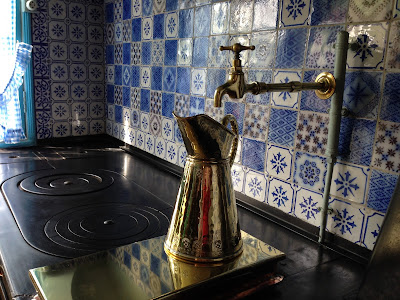It may come as a shock, but Claude Monet didn’t live in his
garden. He lived in a very fine house
overlooking the garden, which he rented for several years before he bought
it. For more than forty years, he would
live in Giverny, expanding his art and expanding his country home into a warren
of spacious rooms, splendid with bountiful color and art. The interior runs from his studio on one end,
to the fabulous kitchen on the other. By
the time of his death in 1926, he had built three studios, one the size of a
high school gymnasium, used to produce his gargantuan water lily studies.
Claude Monet not only lived to paint, but also lived to
sculpt a way of life that we would call stylish and avant-garde. He was a modern man, an art collector, and
ruler of his domain. Where did he get the money? Weren’t all Impressionists dirt poor from
start to finish? Not hardly mon ami.
Monet was apparently a master businessman and his paintings sold well. More and more, art dealers came to him. Unlike
Van Gogh, who sold only a couple of painting in his lifetime and died a pauper,
Monet’s fame spread throughout the world.
Other famous artists, as well as the art dealers, visited often. Monet entertained them in style, and his home
reflected his rustically lavish life.
 |
| The dining room today |
 |
| Design and color |
 |
| Dining Room |
It had not always been so.
Before he was able to buy Giverny, he struggled and lived on the edge of
bankruptcy for years. By the time he purchased
the house and grounds, those days had been lost in the shadows of yesterday.
Monet was a man of color and design, reflected in the length
and breadth of his estate. This was his
world, a wonderful place that even to this day sparkles with fresh delights,
and blossoms with magical hues, from corner to corner. Outside, the vast garden still spreads in an
amazing burst of rainbow colors. Monet also
kept a two and a half acre kitchen garden and much of his family’s food came
from there and the surrounding fields where he and his family and friends, shot
rabbits, and gathered mushrooms, or fished in his famous ponds . The house fit
right into his expressive dream of creating a self-contained center of
tranquility. This extended into his house, with the kitchen an amalgam of rich
blue tiles and spotless copper pots, and the dining room an array of sun-swept
yellows.
 |
| Monet's wife's bedroom, Monet's also has a single bed, but the room is more sparsely decorated. |
Other rooms held patterns of blue and white. He fancied none of the dull and mundane
colors popular at the time. Even the
startlingly green shutters were chosen by Monet, bold and bright, unlike the
usual muted shades on houses of the day.
Every room but the kitchen held masterpiece canvases he'd purchased. Cézanne.
Degas. Japanese wood block prints
and Japanese ceramics of every variety.
Today, what you see on the walls are copies, with few exceptions.
 |
| Japanese ceramics |
About the kitchen.
First things you notice are the blue tiles from Rouen, the array of
original, shiny copper pots, and an enameled iron stove only a bit smaller than
a Sherman tank. The stove is a
wood-burning Briffault, sadly no longer made.
Oh, you can get something similar in gas or electric, but you may have
to take out a second mortgage. Prices I
saw ranged from over $8000 for 1/3 size version, to La Cornue Gran Palais
Cooking Stove for $47,300. Just the
thing for boiling water for Ramin noodles.
A wood-burning stove of this style has no temperature
controls, other than the heat of the wood.
When the fire is going, each oven holds a different temperature, and the
same with each of the iron stovetop plates.
The kitchen was a center of activity, as most kitchens are, and
I suspect Claude Monet viewed a dining table as just another canvas, with the
kitchen his palette.
Monet was serious about food, looking into the details of
every recipe he’d gathered, personally selecting fresh ingredients, and
dictating the bountiful courses served to family and guests. If you would like to read more about the
routines of life at Giverny, I refer you to a wonderful book by Claire Joyes, Monet’s Cookery Notebooks.
At only one cent for a hardback copy, you really should be
ashamed.
In a home, ambiance is everything, and when you walk through
Monet’s home, you feel as comfortable as if the house were built last
year. He was the kind of modernist man who could seamlessly connect art to canvas, garden, and home design.
The rooms are open and effortlessly joined,
with large windows that give the feel of indoor spaces spilling out into the
garden. Makes you understand that Claude
Monet was not only a man of his time, but a man whose art, design, and sense of
color transcend time.
 |
| The first studio as it is today. |
 |
| Claude Monet in his studio |












No comments:
Post a Comment